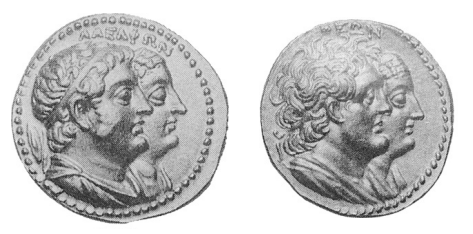Alexandria, gold, mnaieia (jugate busts of Ptolemy VI and Arsinoe/jugates busts of Ptolemy I and Berenike) (180-145 BCE)
From SILVER
180 BCE - 145 BCE Gold 231,895 kg
Description
| ObverseInscription or printing placed on the obverse.: | ΑΔΕΛΦΩΝ (Greek).Draped and diademed bust of Ptolemy IV and draped bust of Arsinoe III right, Compass in the left field |
| ReverseInscription or printing placed on the reverse.: | ΘΕΩΝ (Greek).Draped and diademed bust of Ptolemy I and draped bust of Berenice I right, Leaf in the left field. |
Mint and issuing power
| MintIdentifies the place of manufacture or issue of a numismatic object.: | Alexandria | Ancient regionAncient region.: | Egypt | Modern countryModern country: Egypt | AuthorityIdentifies the issuing power. The authority can be "pretended" when the name or the portrait of X is on the coin but he/she was not the issuing power. It can also be "uncertain" when there is no mention of X on the coin but he/she was the issuing power according to the historical sources: | Ptolemy VI Philometor (Ptolemaic king, 180-145 BC) |
Chronology
| FromIdentifies the initial date in a range assigned in a numismatic context. | 180 BCE | toIdentifies the final date in a range assigned in a numismatic context.. | 145 BCE | PeriodTime period of the numismatic object.: Hellenistic 323-30 BC |
Physical description
| MetalThe physical material (usually metal) from which an object is made.: | Gold |
Median weightMedian of the weights of numismatic objects (in grams). in grams | 27.60 | DenominationTerm indicating the value of a numismatic object. Examples: tetradrachm, chalkous, denarius.: | mnaieion |
StandardStandard.: | Ptolemaic |
References
| Die study referencePublication of the study: | Olivier 20121Olivier 2012, p. 167-168, no. 3352-3359. | ||
| Coin series referenceReference to coin series study: | Svoronos 18902Svoronos 1890, n° 1229 | ||
Reverse dies distribution
no distribution is available
Quantification
| Number of obversesNumber of obverse dies. ᵖ (o) | 7 | Number of singletons (o1)The number of singleton coins. ᵖ | 6 |
| Number of reverse diesNumber of reverse dies. (r) | 7 | Number of coinsNumber of coins. (n) | 8 |
| Coins per obverse dieNumber of coins per obverse die. (n/o) | 1.14 | Coins per reverse dieNumber of coins per reverse die. (n/r) | 1.14 |
| Reverse per obverse ratioRatio of obverse dies divided by reverse dies. (r/o) | 1 | Percentage of singletons (o1)number of coins (n) divided by the number of singletons (o1) ᵖ | 85.71 % |
| Original number of dies (O) (Carter 1983 formula)The estimation of the number of coins according to Carter 1983 ᵖ | 42.01 | Coins struck if 20,000 as average productivity per dieCoins made if the average productivity for obverses (according to Carter) is 20,000. ᵖ | 840,200 |
| Original number of dies (O) (Esty 2011 formula)The estimation of the number of coins according to the singleton formula in Esty 2011 ᵖ (O) | 56 | Survival rate if 20,000 as average productivity per dieSurvival rate if average productivity is 20,000. ᵖ | 0.00001 |
| Coverage (o = % of O) (Esty 1984 formula)Esty 1984 - coverage (% of O) ᵖ (o = % of O) | 25% | Die productivity if survival rate 1/2,000Average productivity if survival rate is 1/2,000. ᵖ | 380.86 |
| Weight of silver (in kg) if 20,000 coins per die (O = Carter formula)Carter 1983 * Median weight * 20000 (*10 if gold or electrum) ᵖ | 231,895 kg <br /> 231,895 kg | Die productivity if survival rate 1/5,000Average productivity if survival rate is 1/5,000. ᵖ | 952.15 |
Remarks
Likely military
References
- ^ Olivier, Julien (2012), Archè et Chrèmata en Egypte au IIe siècle avant J.-C. (204-81 av. J.-C.). Etude de numismatique et d'histoire, [Unpublished doctoral dissertation], Orléans University, 2012.
- ^ Svoronos, Ioannes N. (1890), Numismatique de Crète ancienne, accompagnée de l'histoire, la géographie et la mythologie de l'île. Première partie, description des monnaies, 2 vol., Macon, Impr. Protat frères.
